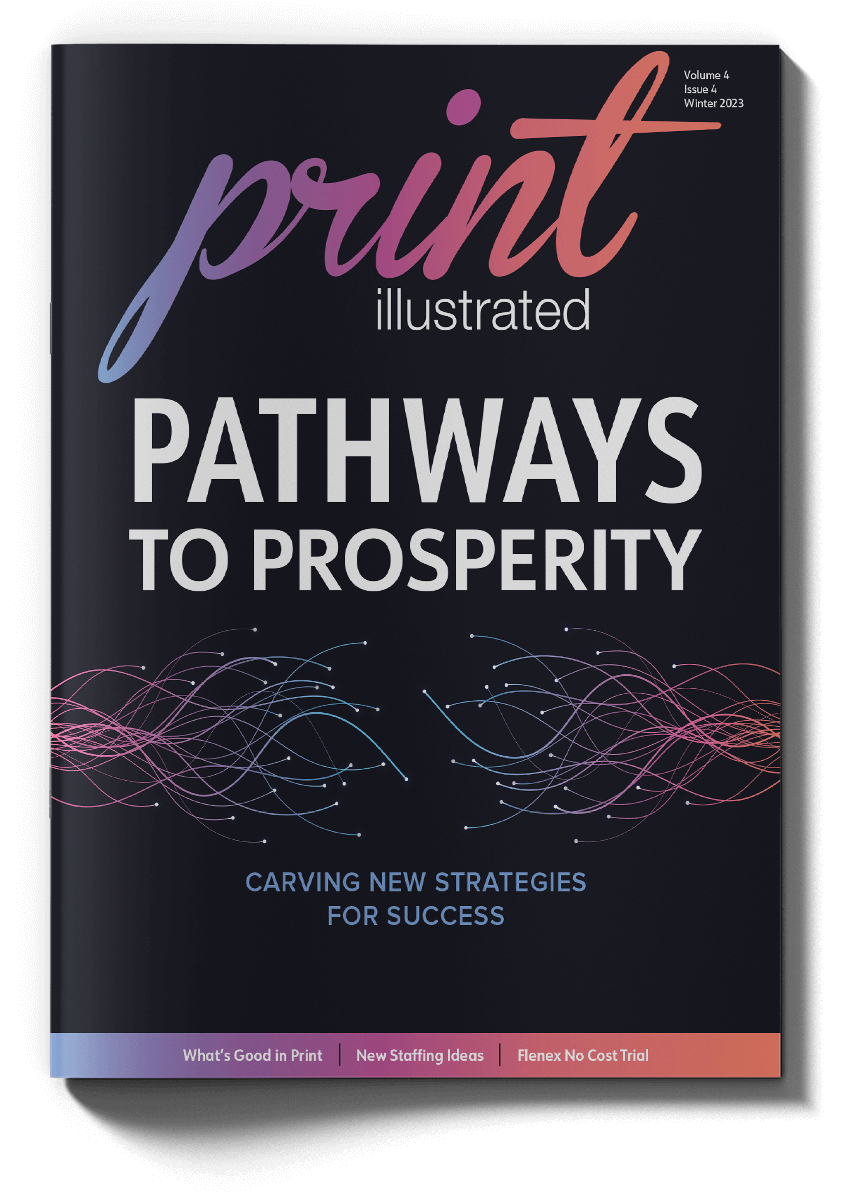Hopkins Printing recently added a large piece of business because another printer would not finish the project for a customer. Roy Waterhouse says the fact that Hopkins stepped in and completed the job was just part of the story. The real story was what happened after the customer approached the Hopkins team with the dilemma.
After taking the time to discuss what was needed and when, Hopkins committed to getting the job finished. For its efforts, it now has been awarded the next few runs for that specific project. “Just saying ‘yes’ and figuring out a solution is the key,” says Waterhouse, VP of Commercial Printing for Hopkins, which has plants in Columbus, Ohio, and Elgin, Illinois. “The biggest way to position yourself for new revenue opportunities is to get in front of existing customers and talk about the challenges they have, and then look for ways to help solve those challenges.”
There is no ignoring that finding the time to sit, think and strategize these opportunities with existing and potential customers takes work. In fact, between work, calls, emails and meetings, finding scraps of time in any day can be a challenge.
“Our investment in new technologies is pivotal moving forward. Coupled with the investment in technology is the investment we must make in security.”
– Scott Hudson, Director of Corporate Communications, Worth Higgins & Associates
For printers like Hopkins, finding new revenue opportunities requires a strategic approach that involves exploring the marketplace, leveraging existing strengths and embracing ever-evolving trends to identify untapped avenues for growth. The process often is a blend of market research, customer-centric initiatives and adaptable business strategies.
For example, Hopkins views growth in three buckets: new business development, organic growth, and partnerships. The printer has a full-time business development person who dedicates his entire day to finding new clients. He keeps them for a short time, gets them on board, and then hands them off to a salesperson or an account manager. Organic growth is conducted by the entire team. It has targets for its largest accounts and targets for new account acquisition within its sales team.

Finally, the Hopkins team looks for strategic partnerships, searching for the needs it offers (take the customer who needed help when another printer couldn’t). “Currently, we are working with a client who has a book of business that fits our equipment,” Waterhouse says. “We manage that through a different process because it does not require a salesperson. The biggest challenge is finding new qualified salespeople and then more team members to get the work done. Equipment and supplies are no longer a challenge.”
In addition, Hopkins’ director of sales regularly researches its customer base searching for new trends and/or pockets of growth. Next, it creates a focused plan to seek out that type of customer in the market. A few years ago, the printers identified retail as a key growth segment and have grown three retailers that are now in their Top 10 accounts.
Like many other printers, Hopkins continues to find its way in the marketplace after the pandemic. On one hand, COVID and the supply disruption have actually made it easier to work with some customers. During all the supply chain issues, it found that its good customers were very flexible to substitute papers and consider different options to keep projects moving forward.
On the other side, with more people working from home, the search for new business has taken some creative adjustments. “It has made the strategy of seeing new prospects in their office a hard challenge,” Waterhouse says. “We started pushing Zoom early during COVID and have found that to work very well. We have also been working with our sales team to use LinkedIn to connect to prospects that are not in the office.”
One of its biggest challenges is getting additional work produced in the plant and finding the right people. The Hopkins HR team has tried many different approaches to help with the problem, including more training, better testing and language training—all of which is designed to attract and retain good team members.
One of those approaches is technology, including ChatGPT. “We can interact with Chat and build our ideal customer, and then ask for companies within a certain radius of our plant,” Waterhouse says. “We have been amazed at how well that has worked in helping to find new prospects.”
Change with the changing times
A long time ago, Scott Hudson learned—and is reminded almost daily—that the only constant in our industry is change. Because of this continual evolution, Hudson, Director of Corporate Communications for Worth Higgins & Associates, believes that printers must take a multi-faceted approach to exploring opportunities for revenue growth.
From diversification of its product offerings to research and innovation, the Worth & Associates team remains committed to staying ahead of market trends and technology. This means strategies like attending industry shows, utilizing vendor recommendations and securing client feedback, among others.
“Our strategies are ever-evolving,” Hudson says. “We use different approaches for different clients and offerings.”

On the print side, Worth Higgins & Associates is always looking for ways to help its clients procure printed products easier and more efficiently. It looks outside the typical channels of ink on paper. While still under wraps, it recently started building out a product offering for a client group that relies on printed products, but does not have the internal infrastructure to manage the design, production and distribution of a wide range of products. Right now, it has assembled a team to handle all of those processes turnkey.
On the wide format and signage side, Worth Higgins & Associates engages with a completely different audience that requires a different sales approach. As it continues to build relationships with this new audience and fine tune the process, the brand has been recognized and the growth has followed.
“I think all printers have seen this evolution in their businesses with digital printing and personalization,” Hudson says. “Our investment in new technologies is pivotal moving forward. Coupled with the investment in technology is the investment we must make in security. We have seen the transition in RFQs asking mainly about print capabilities to the main focus being around security, which can be just as big of an investment.”
“The biggest way to position yourself for new revenue opportunities is to get in front of existing customers and talk about the challenges they have.”
– Roy Waterhouse, VP of Commercial Printing, Hopkins Printing
In an industry frequently confronted with change, the process to continually find ways to transform is dynamic. The strategy requires openness, flexibility and a willingness to embrace new perspectives, and involves the need to actively seek opportunities within the shifting landscape.
The strategy and the efforts to do so are not without challenges, especially in today’s technology focused climate. Along with product changes come changes in client behavior. “I would say the need for security and protecting client data is critical,” Hudson says. “Over the past year, we have seen the requirements becoming much more stringent and we strive to stay ahead of what clients require. I think the biggest opportunity is going to be in AI and how we incorporate it into our businesses. I think the biggest challenge is the labor force and attracting youth to our industry.”
In today’s ever-evolving landscape, the need to carve out new strategies is not just a necessity, but an artform. By embracing change, leveraging trends and opening their minds to explore new opportunities, today’s printers can create a pathway to prosperity.

